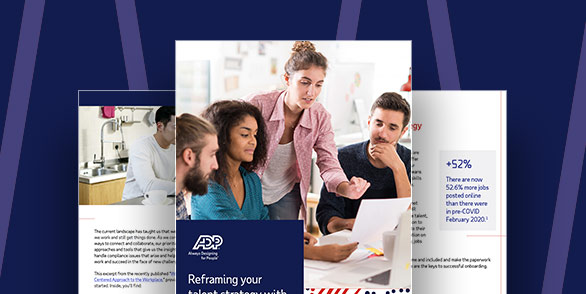Onboarding is how new employees are integrated into an organization and familiarized with its management teams, culture and business model. The process often consists of orientation and official training, including but not limited to the code of business conduct. Employees may also be given reference materials on job specifications, products and services. When done correctly, onboarding helps engage new hires from the beginning and drives loyalty, retention and productivity.
Table of Contents
Onboarding vs. orientation
Orientation is a one-time event that outlines an employee’s role with a new company, whereas onboarding is an ongoing activity with regular check-ins between employers and new employees. The duration of onboarding may be as short as a few weeks or as long as a full year.
Goals of orientation
Orientation is highly focused on compliance-related activities. During this time, employees typically:
- Finalize necessary forms and paperwork
- Receive a formal introduction to company policies, procedures and values
- Review and select employee benefits
- Validate their decision to join the organization
Goals of onboarding
Onboarding is all about connection. With that in mind, employers seek to:
- Fully integrate employees and reinforce their roles
- Support two-way communication between themselves and employees
- Provide information customized to employees’ various jobs
- Ensure employees understand their goals and have the support needed to reach them
- Continue to validate employees’ decisions to join the organization
Onboarding processes
To improve engagement and retention without overextending resources, employers need to choose the right mix of onboarding activities. Many businesses consistently make it a point for new hires to:
- Communicate with managers before their first day
- Get to know the names and faces of team members
- Go on a tour of the office or workplace
- Check-in with managers regularly
- Learn about areas around the workplace
- Partake in ice breakers to connect with colleagues
- Have a mentor or buddy assigned to them
How to make onboarding a positive experience
Ad hoc, paper-driven or unstructured onboarding programs can jeopardize desired business outcomes, i.e., productivity, engagement and retention. If new team members seem confused or overwhelmed, it may indicate that onboarding processes need improvement. Here are some tips on how to onboard employees in ways that enhance their experience:
- Provide clear instructions for the first day and/or week
Letting new hires know exactly where to go, what to do and who they’ll be working with can help them feel more comfortable at the start of their tenure. - Complete forms and paperwork ahead of time
Sending new hires administrative paperwork in advance, to the extent permitted by legal requirements, saves time and makes for a more impactful first day. - Encourage social connections
When new employees have opportunities to connect with colleagues and leaders – either through team-building activities or employee resource groups (ERGs) – they may start to develop loyalty and goodwill toward the organization. - Check-in frequently
Whether daily or weekly, regular check-ins allow employees to ask questions and provide their managers with valuable feedback on the onboarding process. - Take advantage of technology
An integrated onboarding system can help automate administrative tasks, like form submission, and may serve as another communication channel with new hires.
Onboarding remote employees
Remote work, by its nature, can make onboarding challenging. However, it is possible to create an experience that’s just as positive and nurturing for remote workers as it is for those on-site. One of the primary keys to success is ensuring that employees have access to everything they need for their job – computer equipment, software credentials, fleet vehicles, etc. – before their start date.
Effective communication via technology is also essential when onboarding remote employees. It may be helpful to send a series of personalized emails that welcome employees to the organization and direct them to digital resources, such as:
- Virtual tours
- Orientation videos
- e-Learning tools
- Online handbooks and directories
Frequently asked questions about onboarding
What are the three phases of onboarding new employees?
Many employers think of onboarding as a singular process, but there are actually three parts to it, each with a distinct purpose:
- Pre-boarding – engage with the employee before the first day
- Orientation – outline the employee’s role as part of a one-time event
- Onboarding – check the progress of the employee’s integration at regular intervals
What are the three C's of employee onboarding?
A successful onboarding experience generally consists of three C’s:
- Connection – Employee satisfaction and assimilation that lead to retention
- Comfort – Bonds between employees, their managerial team and the organization that lead to effective working relationships and productivity
- Culture – Workplace norms, expectations and values that shape career development and purpose-driven work
How long does the onboarding process for new employees take?
The average employee onboarding experience lasts approximately seven days. However, to avoid overloading new hires with information in a short period, some employers make onboarding a year-long process with checkpoints at 30, 60 and 90 days.
What are some onboarding best practices?
While there are numerous small details to manage when a new hire joins a company, creating and deploying an effective employee onboarding process comes down to these best practices:
- Design onboarding for both managers and employees
- Design onboarding for a digital and mobile world
- Customize onboarding to individual roles or groups within the organization
- Listen to employee feedback on the onboarding program
What makes a good onboarding experience?
Every organization’s culture is different, but employers can generally make onboarding a positive experience by clearly communicating goals and meeting five essential employee needs:
- Freedom
- Knowledge
- Stability
- Self-management
- Meaning
This guide is intended to be used as a starting point in analyzing the onboarding definition and is not a comprehensive resource of requirements. It offers practical information concerning the subject matter and is provided with the understanding that ADP is not rendering legal or tax advice or other professional services.





